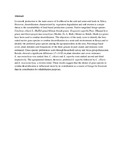Quantifying the synergistic effect of the precipitation and land use on sandy desertification at county level: A case study in Naiman Banner, northern China
Assessing the driving forces of sandy desertification is fundamental and important for its control. It has been widely accepted that both climatic conditions and land use have great impact on sandy desertification in northern China. However, the relative role and synergistic effect of each driving force of sandy desertification are still not clear. In this paper, an indicator named as SI was defined to represent the integrated probability of sandy desertification caused by land use.



